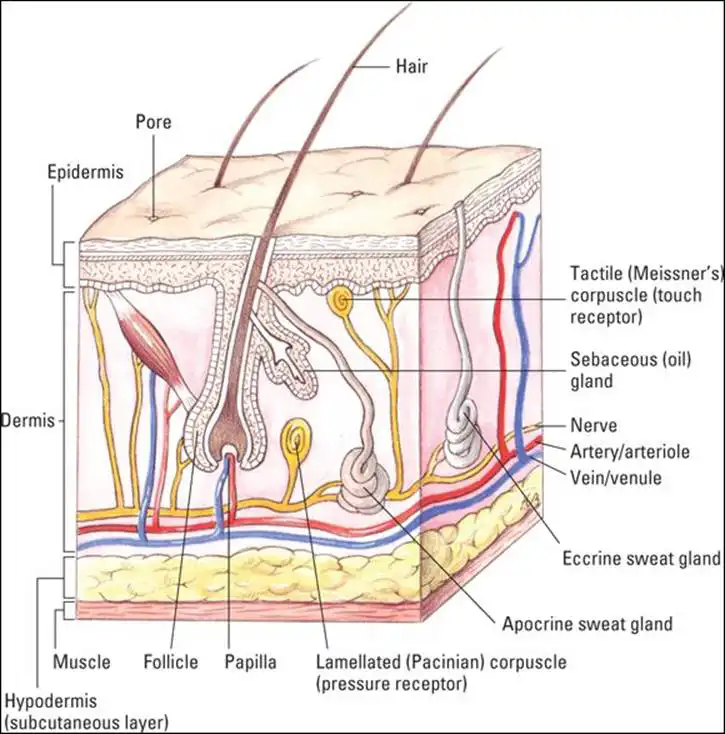Seeing what the integument does
The skin is the largest organ of the human body. In a human adult, the skin covers an area of about 20 square feet (almost 2 square meters), or about the size of a small blanket — a soft, pliable, strong, waterproof, and self-repairing blanket. It accounts for about 5 percent to 7 percent of the body’s weight.
The skin and its appendages (hair, nails, and so on) form your outer covering, or integument. Though it is one of the most beautiful parts of you, it’s also a complex organ system with numerous types of tissue and many specialized structures. The average square inch (about 6.5 square centimeters) of skin holds 650 sweat glands, 20 blood vessels, more than 1,000 hair follicles, half a million melanocytes (pigment cells), and more than 1,000 nerve endings. Refer to the "Skin (Cross Section)" color plate in the center of the book to see a detailed cross section of the skin.
Skin is made in layers, and layers within layers. New cells begin life in the lower levels and are gradually pushed to the surface to replace the old, dead ones. By the time the new cells reach the top, they’ve become hard and flat, like roof shingles. Eventually, they pop off like shingles blown from a roof in a strong wind.
Amazingly, every minute, 30,000 to 40,000 dead skin cells fall from your body. In approximately a month’s time, all the cells on the top layer have blown off and been replaced.
In this chapter, we show you what your skin is made of, and we explain how your hair and nails form. We also look at the functions of your skin and what diseases and conditions can take a toll on your integument.
Functions of the integument
The entity known as you is bounded by your integument. The skin mediates much of the interaction between you and not-you — the environment. Your integument identifies you to other humans, a very important function for members of the hypersocial human species. Here’s a look at the integument’s other important functions:
- Protection: Skin protects the rest of the body by keeping out many threats from the environment, such as pathogens, damaging solar radiation, and nasty substances everywhere.
- Thermoregulation: The skin and its appendages in particular support thermoregulation (maintaining a consistent body temperature) in several ways. See the "Controlling your internal temperature" section later in this chapter.
- Water balance: The skin’s outer layers are more or less impermeable to water, keeping water and salts at an optimum level inside the body and preventing excess fluid loss. A small amount of excess water and some cellular waste are eliminated through the skin.
- Incoming messages: Many types of sensory organs are embedded in your skin, including receptors for heat and cold, pressure, vibration, and pain. See the "Your skin is sensational" section later in the chapter.
- Outgoing messages: The skin and hair are messengers to the outside environment, mainly to other humans. People get information about your state of health by looking at your skin and hair. Your emotional state is signaled by pallor, flushing, blushing, goose bumps, and sweating. The odors of sweat from certain sweat glands signal sexual arousal.
- Substance production: Sebaceous glands in the skin, usually associated with a hair follicle, produce a waxy substance called sebum for waterproofing. Sweat glands in the skin make sweat. In fact, your skin has several different types of glands, and each makes a specific type of sweat. See the "Nothing’s bland about glands" section later in the chapter.
Skin cells produce keratin, a fibrous protein that’s an important structural and functional component of skin and is, essentially, the only component of hair and nails. See the "Caring about Keratins" sidebar later in the chapter.
![]() The root of integument is integr-, meaning "whole" as in integer (a whole number), integrate (to bring different parts together into one), integral (inseparable from the whole), and integrity (always a positive term, but more difficult to define).
The root of integument is integr-, meaning "whole" as in integer (a whole number), integrate (to bring different parts together into one), integral (inseparable from the whole), and integrity (always a positive term, but more difficult to define).
See also
- Locating Physiology on the Web of Knowledge
- Chapter 1. Anatomy and Physiology: The Big Picture
- Chapter 2. What Your Body Does All Day
- Chapter 3. A Bit about Cell Biology
- Sizing Up the Structural Layers
- Chapter 4. Getting the Skinny on Skin, Hair, and Nails
- Chapter 5. Scrutinizing the Skeletal System
- Chapter 6. Muscles: Setting You in Motion
- Talking to Yourself
- Chapter 7. The Nervous System: Your Body’s Circuit Board
- Chapter 8. The Endocrine System: Releasing Chemical Messages
- Exploring the Inner Workings of the Body
- Chapter 9. The Cardiovascular System: Getting Your Blood Pumping
- Chapter 10. The Respiratory System: Breathing Life into Your Body
- Chapter 11. The Digestive System: Beginning the Breakdown
- Chapter 12. The Urinary System: Cleaning Up the Act
- Chapter 13. The Lymphatic System: Living in a Microbe Jungle
- Life’s Rich Pageant: Reproduction and Development
- Chapter 14. The Reproductive System
- Chapter 15. Change and Development over the Life Span
- The Part of Tens
- Chapter 16. Ten (Or So) Chemistry Concepts Related to Anatomy and Physiology
- Chapter 17. Ten Phabulous Physiology Phacts
- Supplemental Images





